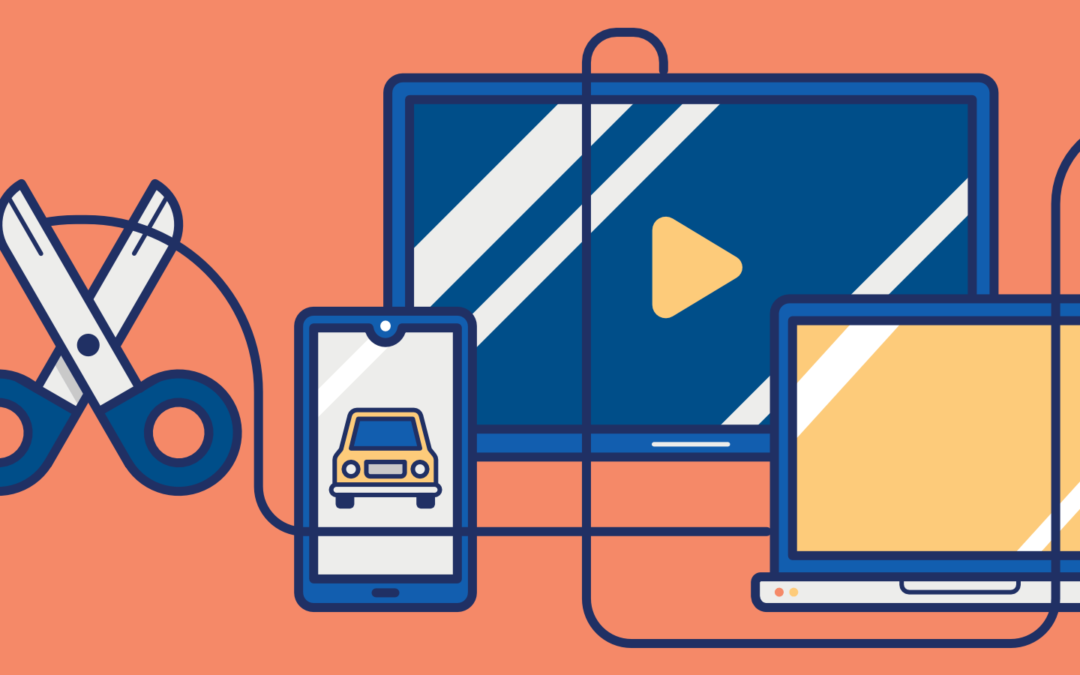The death of linear television is imminent. According to recent study, 88% of US households use video streaming services, versus only 50.8% who use linear TV.
By abandoning network television’s constrained offerings, cord-cutters have ushered in a new age of streaming and digital media.
The new frontiers for marketers seeking to reach cord-cutters and tech-savvy consumers in the era of streaming are Over-The-Top (OTT) and Connected TV (CTV).
Advertisers can use OTT and CTV to reach new audiences in micro-targeted, measurable, and economical ways as more viewers turn away from conventional linear TV.
We’ll go over the distinctions between OTT, Linear TV, and CTV in this article, as well as the advantages of using OTT and CTV advertising and which options might be best for your company’s requirements.
📺 What is cord-cutting? 📺
“Cord-cutting,” the act of terminating or giving up a traditional cable or satellite TV subscription in favor of streaming video material online, has been prompted by the growth of CTV and OTT.
To access their preferred TV programs, movies, and other video content, cord cutters typically depend on Over-the-Top (OTT) platforms like Netflix, Hulu, Amazon Prime Video, and other streaming services.
What is CTV (Connected TV)?
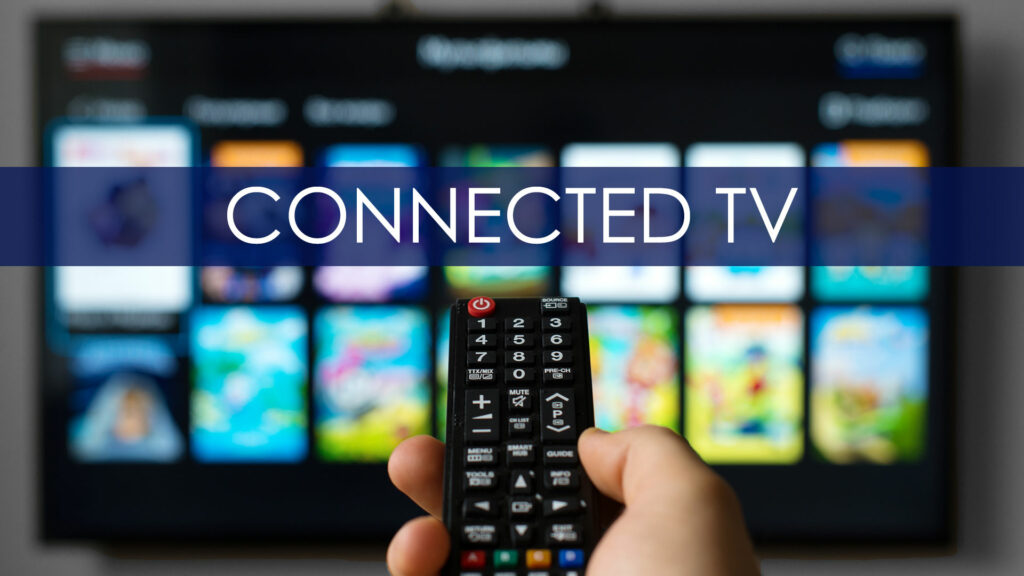
A connected TV (CTV), also known as a smart TV, is a television or TV plug-in that has internet access and can access streaming services, online video, and other digital media.
With CTVs, you can use platforms or apps installed directly on the TV to access a variety of internet-based video content, including TV programs, movies, and live events.
Some examples of CTVs include:
- Roku
- Apple TV
- Amazon Fire
- Smart TVs like Samsung, LG, and Sony
CTVs are televisions with integrated internet capabilities but exclude other types of devices such as smartphones, tablets, and desktops.
What is OTT (over-the-top)?
Bypassing established broadcast or cable distribution channels, over-the-top (OTT) refers to the direct delivery of digital media material to viewers over the internet.
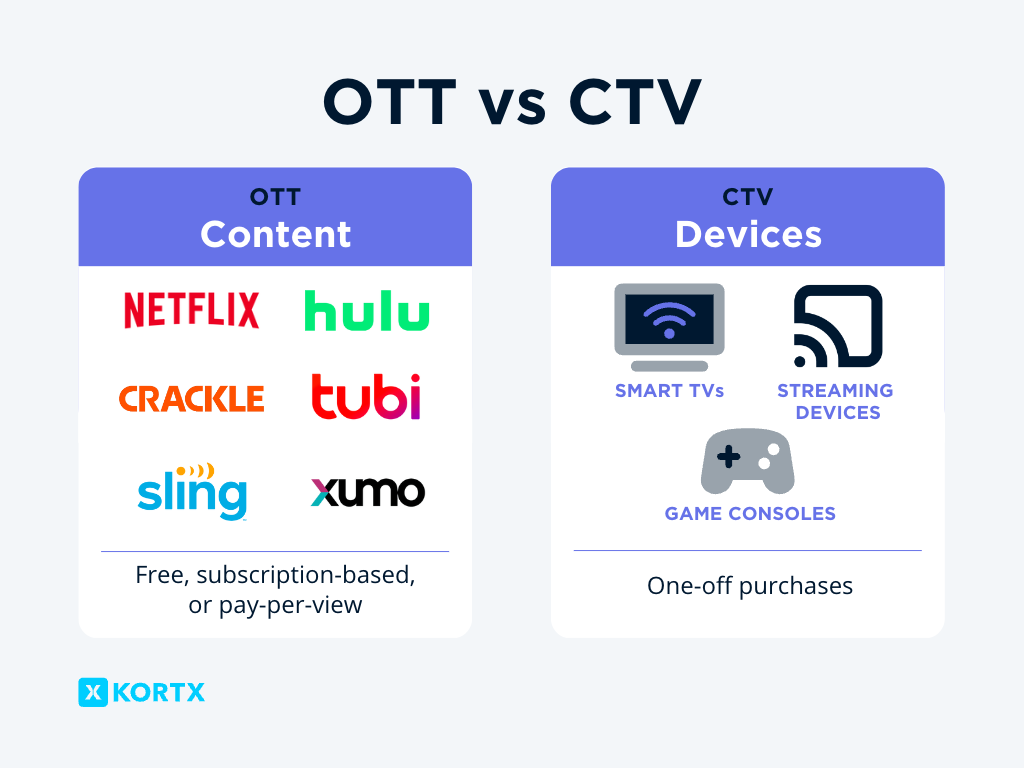
Through apps or platforms on a variety of gadgets, including smartphones, tablets, smart TVs, and streaming devices, viewers can receive OTT services.
Examples of popular OTT video streaming services are
Netflix (231 million subscribers)
Hulu (47.2 million subscribers)
Amazon Prime Video (>200 million subscribers)
Disney+ (161.8 million subscribers)
Linear TV: What is it?
Traditional broadcast television programming is delivered through planned programming on linear TV, which forbids viewers from pausing, rewinding, or fast-forwarding through anything they are currently watching.
Through an antenna, cable, or satellite TV service, linear TV can be accessed.
Some examples of linear TV channels include:
- ABC
- NBC
- CBS
- Fox
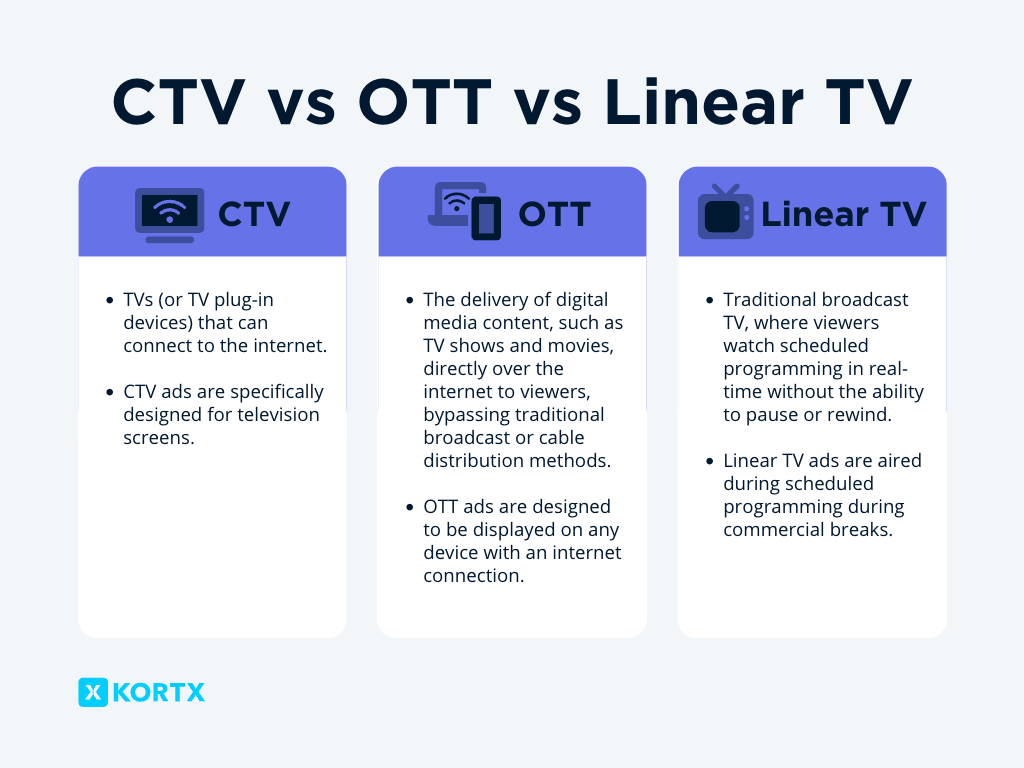
What distinguishes CTV, OTT, and linear television?
Although OTT and CTV are frequently used equally by marketers, they are not the same thing. Through OTT, viewers can receive streaming content, and CTV offers the display platform.
A CTV is a TV (or a TV plug-in device) that can connect to the internet, whereas OTT content can be streamed from any device with a screen and an internet connection because it is pulled straight from the internet.
Linear TV and OTT are comparable because CTV refers to the location of the delivery of information, whereas Linear TV describes the method of delivery.
To view White Lotus, for instance, you might turn on your smart TV (CTV), launch the HBO Max app (OTT), and type “White Lotus” into the app’s search bar.
You can only watch “White Lotus” when it is set to air live on Linear TV, including dumb and smart TVs (CTV).
A CTV is, once more, a TV that is linked to the internet, whether it be a smart TV or one that is attached to a stick, box, or gaming console. Additionally, CTVs can stream Linear TV programming because they can:
- Connect to a cable box
- Receive Linear TV broadcasts through built-in tuners (without the need for an external device)
You can use your smart TV to connect to your cable or satellite provider and tune in to the appropriate channel to watch the live broadcast as it occurs, for instance, if a local news station is showing a live evening news broadcast at a set time on a particular channel.
After discussing the distinctions between OTT, CTV, and linear TV, let’s examine the advantages of advertising on OTT and CTV in more detail.
The Benefits of OTT and CTV Advertising
Hyper-personalized ad experience
Broad-casting traditional linear television. While a sizeable percentage of the population might see your advertisement, the varied demographics may prevent it from engaging all viewers, causing some to pass it by.
By using third-party audience targeting, customizing, and playing different advertisements for different viewers based on their demographics and interests, OTT content provides addressable advertising.
Advertisers can micro-target viewers with addressable ads to generate the most engagements.
Consider the scenario where an 85-year-old grandmother and a 25-year-old single graduate student both watch the same “White Lotus” episode. By displaying entirely different advertisements to viewers, an advertiser could hyper-personalize the watching experience. For example, they could send the grandmother an advertisement for a comfortable mattress and the college student an advertisement for a Peloton.
Advertisers can use OTT advertisements to target particular demographics, including
- Age
- Gender
- Location
- Job title
- Education level
- Income
- Ethnicity
By using OTT, advertisers can precisely target their desired customers instead of employing a broad TV commercial approach, which is why it’s a logical choice for marketers.
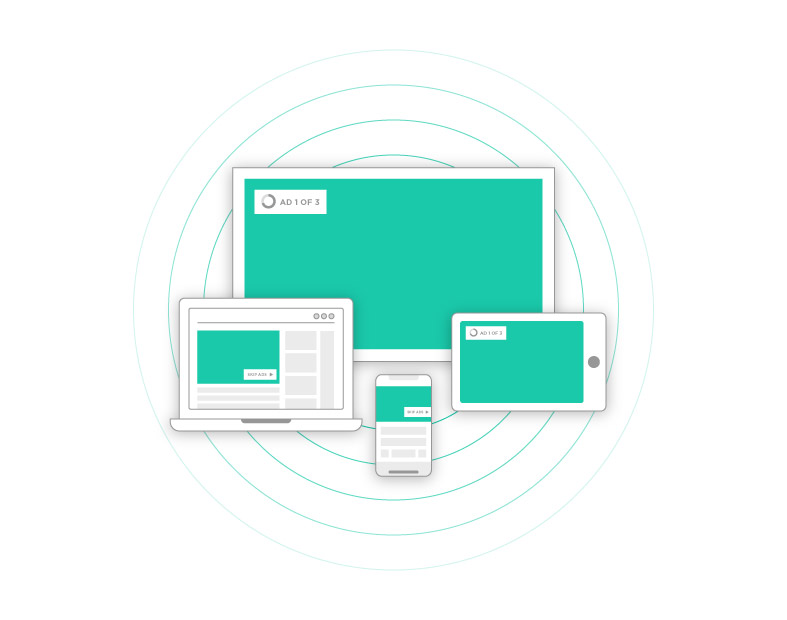
A growing ad market
By 2024, more than one-third of US homes will no longer receive cable television, predicts eMarketer. As more people choose to discontinue their conventional TV subscriptions, OTT and CTV platforms can now successfully target these audiences with advertising.
💥 Here’s proof of OTT’s strength with modern audiences:
- 87% of US households have at least one CTV device.
- 88% of US households have at least one OTT video service, with the average US consumer subscribing to at least four services.
- 50.8% of households subscribe to Linear TV, a number projected to decrease to only 40.2% by 2026.
- In 2023, US viewers will spend more than an hour and a half per day with subscription over-the-top (OTT) services.
Advertisers can also target a younger population with OTT/CTV marketing. The number of viewers of linear TV who were 18 to 24 years old decreased by 23.4% between 2020 and 2021 among young adults. And the 12- to 17-year-old age group is the first generation that is more accustomed to viewing streaming content on CTVs than traditional TV.
Overall, the increasing cord-cutting trend and the widespread adoption of CTV and OTT services among US households have made these platforms effective for advertisers to reach modern audiences, particularly the younger demographic who may be more familiar with streaming content on CTVs than traditional TV.
How to Assess the Efficiency of TV Advertising
OTT advertising has many advantages, including the ability to reach viewers who have stopped watching traditional TV and target particular audiences.
To calculate the return on investment, it’s crucial to measure the effectiveness of all types of advertising.
The effectiveness of OTT advertising can be determined using two primary techniques:
- Video Completion Rate (VCR): How many times people finished watching the ad.
- Post-view attribution tracking: Connecting the viewership with completing an intended action like visiting a website, downloading an app, or going into a physical store.
Because viewers must complete watching the advertisement before accessing the rest of their intended programming, VCR is the best indicator of success. Or, to put it another way, because they have to.
For instance, imagine you’re watching streaming content while lounging on your sofa. Whether it’s pre-, mid-, or post-show, you’ll have to watch the commercial because there is no way to avoid it. To access the information, you must wait. Only if you stop using the service or device can you view the entire advertisement.
Post-view attribution monitoring is another typical metric. You cannot serve an advertisement with a CTA that says, “Click here to buy this product!” as CTV/OTT ads are through streamed content.
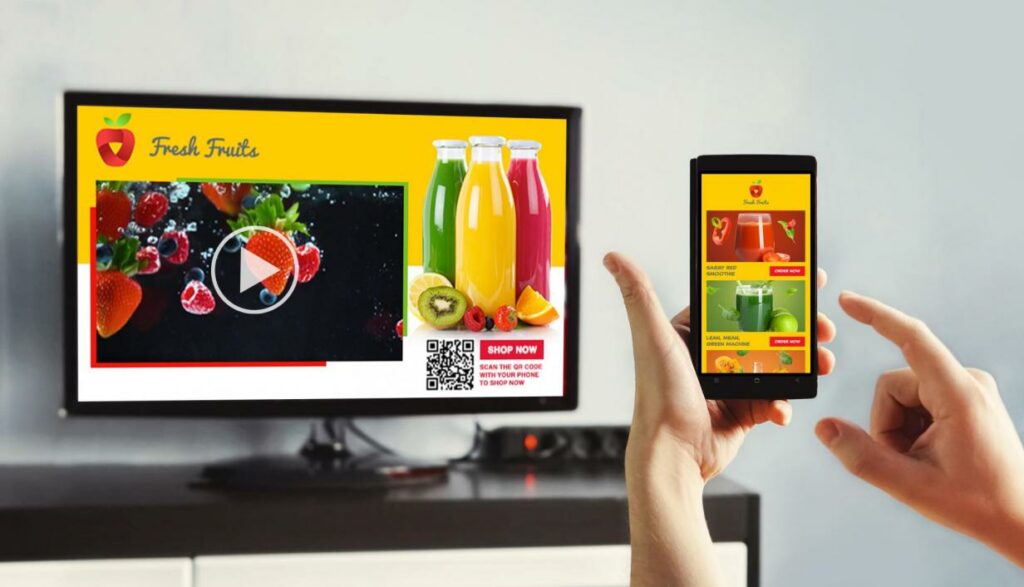
However, you can run CTV advertisements for items that people can purchase. Even though they are unable to act on the advertisement, they may still see it and three days later look it up online and buy it.
The Future of OTT/CTV
The future of OTT/CTV is very bright as its technological capabilities develop further, and the strategic approach will continue to deliver on three crucial facets: functionality, measurement, and inventory.
Functionality
- QR codes: Bridging the gap between offline and online advertising, QR codes can drive traffic from a TV commercial to a landing page or other desired online destination.
- Overlays: Overlays can display a call-to-action (CTA) or message during an ad encouraging viewers to take a specific action, like visiting a website, making a purchase, or downloading an app.
- Picture-In-Picture (PIP): PIP allows viewers to continue watching video content while simultaneously viewing an advertisement, making it a less intrusive ad format.
Measurement
When comparing CTV to metrics like VCR, digital marketers are using more complex techniques.
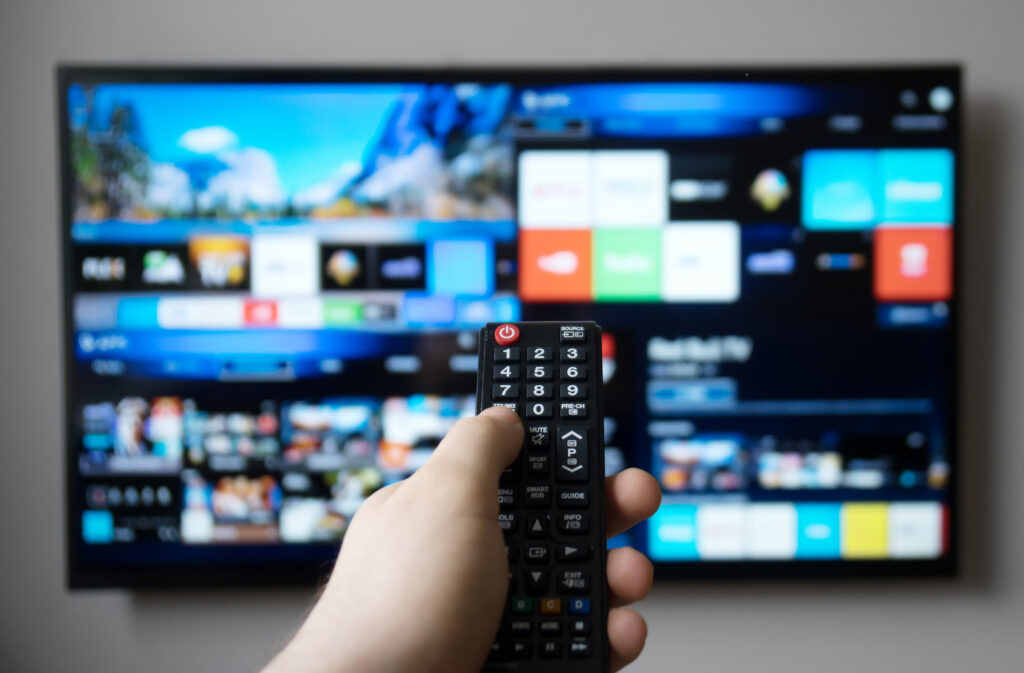
Engagement with interactive creative elements, attribution against onsite page visits or actions, and external Third-Party solutions such as foot traffic or brand lift all provide more sophisticated CTV measurement capabilities that enable brands to assess the value of this media tactic within their holistic marketing plan.
Inventory
The number of platforms and companies shifting their focus to OTT platforms, where they can aggregate all of their content and reach a larger audience, is increasing as linear viewership continues to decline.
Due to this tendency, films that are not likely to be released in theaters are now available as streaming content on OTT platforms.
TV/Movie content and advertisers now have a new channel through which to contact consumers thanks to the expansion of OTT platforms, and this channel will only continue to expand as more money is invested in OTT technology.
Making Sense of OTT: Cutting the Cord
OTT and CTV have emerged as the new frontiers for marketers looking to connect with tech-savvy customers as more households cut the plug on linear TV. While CTV is a television set with internet connectivity and access to online content, streaming services, and other digital media, OTT is the direct transmission of digital media content over the internet. While they can both be used interchangeably, OTT provides the material while CTV offers the viewing platform.
Due to the broad audience that traditional linear TV reaches, not all of its viewers may be interested. Advertisers can target particular demographics while still casting a broad net by using OTT and CTV to deliver a more individualized ad experience.
Download The Radiant App To Start Watching!
Web: Watch Now
LGTV™: Download
ROKU™: Download
XBox™: Download
Samsung TV™: Download
Amazon Fire TV™: Download
Android TV™: Download

